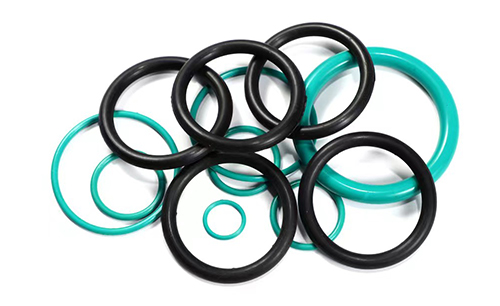HNBR strengthens NBR further, mainly in terms of temperature and ozone resistance.
We supply HNBR Gaskets, HNBR O-ring and HNBR Cords to leading oil fields in China.
Our HNBR Product
Material DataSheet of HNBR
Abbreviation: HNBR
ASTM D-2000 Classification: DH
Chemical Definition: Hydrogenated Acrylonitrile Butadiene
RRP Compound Number Category: 30000 Series
| Durometer or Hardness Range | 30 – 95 Shore A |
| Tensile Strength Range | 1,500 – 3,500 PSI |
| Elongation (Range %) | 90 % – 550 % |
| Abrasion Resistance | Good to Excellent |
| Adhesion to Metal | Excellent |
| Adhesion to Rigid Materials | Good to Excellent |
| Compression Set | Good to Excellent |
| Flex Cracking Resistance | Fair to Good |
| Impact Resistance | Excellent |
| Resilience / Rebound | Good |
| Tear Resistance | Good to Excellent |
| Vibration Dampening | Fair to Good |
| Acids, Dilute | Good |
| Acids, Concentrated | Fair to Good |
| Acids, Organic (Dilute) | Good |
| Acids, Organic (Concentrated) | Fair to Good |
| Acids, Inorganic | Fair to Good |
| Alcohol’s | Good to Excellent |
| Aldehydes | Fair to Good |
| Alkalies, Dilute | Good |
| Alkalies, Concentrated | Poor to Good |
| Amines | Good |
| Animal & Vegetable Oils | Good to Excellent |
| Brake Fluids, Non-Petroleum Based | Fair |
| Diester Oils | Good |
| Esters, Alkyl Phosphate | Poor |
| Esters, Aryl Phosphate | Poor to Fair |
| Ethers | Poor to Fair |
| Fuel, Aliphatic Hydrocarbon | Excellent |
| Fuel, Aromatic Hydrocarbon | Fair to Good |
| Fuel, Extended (Oxygenated) | Good to Excellent |
| Halogenated Solvents | Poor to Fair |
| Hydrocarbon, Halogenated | Poor |
| Ketones | Poor |
| Lacquer Solvents | Fair |
| LP Gases & Fuel Oils | Excellent |
| Mineral Oils | Good to Excellent |
| Oil Resistance | Good to Excellent |
| Petroleum Aromatic | Good to Excellent |
| Petroleum Non-Aromatic | Good to Excellent |
| Refrigerant Ammonia | Good |
| Refrigerant Halofluorocarbons | R-11, R-12, R-13 |
| Refrigerant Halofluorocarbons w/ Oil | R-11, R-12 |
| Silicone Oil | Good to Excellent |
| Solvent Resistance | Poor |
| Low Temperature Range | - 70º F to -30º F |
| Minimum for Continuous Use (Static) | - 40º F |
| Brittle Point | - 70º F to -30° F |
| High Temperature Range | + 250º F to + 300º F |
| Maximum for Continuous Use (Static) | + 325º F |
| Colorability | Excellent |
|---|---|
| Flame Resistance | Poor |
| Gas Permeability | Fair to Excellent |
| Odor | Good |
| Ozone Resistance | Good to Excellent |
| Oxidation Resistance | Excellent |
| Radiation Resistance | Fair to Good |
| Steam Resistance | Fair to Good |
| Sunlight Resistance | Good to Excellent |
| Taste Retention | Fair to Good |
| Weather Resistance | Good to Excellent |
| Water Resistance | Excellent |
More About HNBR
HNBR is a hydrogenated version of NBR (nitrile) rubber, a copolymer of ACN and 1,3-butadiene. It has better performance than NBR, as in the case of HNBR, the NBR is hydrogenated in a catalytic hydrogenation process.
HNBR is widely known for its physical strength and retention of properties after long-term exposure to heat, oil, and chemicals. Depending on filler selection and loading, HNBR compounds typically have tensile strengths of 20 – 31 MPa when measured at 23 °C.
Compounding techniques allow for HNBR to be used over a broad temperature range, -40 °C to 150 °C, and 160 °C in oil, with minimal degradation over long periods of time. For low-temperature performance, low ACN grades should be used; high-temperature performance can be obtained by using highly saturated HNBR grades with white fillers.
As a group, HNBR elastomers have excellent resistance to common automotive fluids (e.g., engine oil, coolant, fuel, etc.) and many industrial chemicals. Like NBR, fluid and chemical resistance improves as the ACN content is increased.





